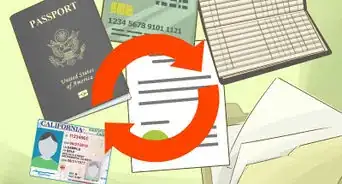This article was co-authored by Jennifer Mueller, JD. Jennifer Mueller is an in-house legal expert at wikiHow. Jennifer reviews, fact-checks, and evaluates wikiHow's legal content to ensure thoroughness and accuracy. She received her JD from Indiana University Maurer School of Law in 2006.
There are 17 references cited in this article, which can be found at the bottom of the page.
This article has been viewed 82,868 times.
In Oklahoma, legal name changes must be approved by the court. The reasons you may want to change your name are as varied as the citizens of the Sooner state. An adopted child may want to return to their birth name, someone may want to take the name of a step-parent, or you may want to have a different name for religious or other personal choice. Regardless of the reason, the state of Oklahoma allows any resident over the age of 18 to petition the court to legally change their name.
Steps
Preparing and Filing the Petition for Name Change
-
1Verify your eligibility to file to change your name in Oklahoma. Before you can file your name change petition with the appropriate court, you must be at least 18 years old and have lived in the state of Oklahoma for at least 30 days immediately before the filing date of your petition. [1]
-
2Determine where you will file your name change petition. You must file at the courthouse in the county where you have lived for at least 30 days even if another courthouse is closer. For the purposes of this statute, living on a military base counts toward the 30 days, even if you've kept your legal residence in another state.[2] The courthouse will be located in the city or town that is the county seat.Advertisement
-
3Estimate the fees and other costs. You do not have to have an attorney to change your name, but you must pay a filing fee to the court and a publication fee to the newspaper. There may also be miscellaneous costs for the notary and photocopies.
- Court filing fees change often, so contact the court clerk to verify the current fee and about their payment methods. Each court has its own rules on payment and many courts do not accept personal checks or credit cards. A money order or cash in the exact amount may be your only options.
- If you cannot pay the filing fee, the court may waive it by a showing of good cause. Print out and complete a financial statement called a Pauper's Affidavit and include it when you file your application. The judge will accept or reject it before issuing your name change order. The judge may also require proof of your income and expenses. [3]
-
4Gather the information you'll need to compete the petition. Oklahoma is very specific about what information is required to be submitted to the court. Most of it is basic, including your name, address, county of residence, birth date, state of birth, and phone number. [4]
- Include both your exact legal name as shown on your birth certificate and the exact legal name you are requesting from the court. Do not use nicknames or initials or they will become part of your new legal name. For example, say "Thomas Daniel Smith," instead of "Tom D. Smith."
- Include the registration number from your birth certificate. If you do not have a copy of your birth certificate, you will need to contact the vital records department of the state or county where you were born and order a certified copy. [5]
- Add a concise, no more than one sentence, reason why you want to change your name. For example, "I was adopted as a child and want to go back to my birth name," or "I want to take my grandfather's name as my middle name." Keep it clear and simple.
-
5Choose the newspaper for publication and verify the cost of the notice. Oklahoma law is clear. You must publish the notice of your intent to change your name with a "legal notice" newspaper for your county or a newspaper that is in general circulation throughout the state. [6] [7] The Oklahoma Press Association keeps a list of its members that meet the state definition of a legal notice newspaper.
-
6Complete the application for legal name change. Legal Aid of Oklahoma has created a straightforward fill-in-the-blank application that will work in all counties. Print it out and fill in all the information on the forms (petition, verification, notice of hearing, and order.) Do not leave anything except the signature blocks blank. You can print clearly in dark ink or use a typewriter. [8]
-
7Sign your petition and other documents with your current legal name in front of a Notary Public. You will need one form of identification showing your current legal name so the notary can verify your identity. [9] Blue ink is preferred because it makes it easy to distinguish the original from a copy. Make at least two copies of the completed and signed documents.
Filing and Publishing the Name Change Application
-
1File your documents with the court clerk at the county courthouse. At this time you must pay the filing fee or include your Pauper's Affidavit.[10] When you file your documents, they become part of the public record. The clerk will assign a case number, a judge, and add the official stamp of the court. Once the petition is filed, you can't change it without difficulty, so make sure you've double-checked all the information. After you receive your copy of the file-stamped documents, keep them in a safe place. If you lose them, the court may charge you for another copy.
-
2Request a hearing date. This is the day you will appear in front of the judge to formally ask to change your legal name. The date must be far enough out to allow you to publish your notice and wait 10 days after it has published. The clerk will fill in the information on your notice of hearing. [11]
-
3Publish notice of your intent to change your name. Take your file-stamped documents to the newspaper that is a legal notice publication for your county. You will have to pay the publication fee before the newspaper will accept and run your notice. Keep the receipt in case the judge asks to see it during your hearing. Oklahoma requires your notice to run in the newspaper once. [12] This is to give general notice to the community of your intent to change your name and to notify anyone who may object. Ask the newspaper if they will send your proof of publication or if you need to come into the office.
-
4Submit proof of publication to the court before your hearing. Oklahoma legal notice newspapers have a publication affidavit you can submit along with a clipping of the notice. Unless publication is explicitly waived, the judge will not grant your name change without proof of publication.
- The judge will only waive publication of your notice if it would put you in danger. If you are a victim of domestic violence, at the time of filing, ask the court clerk about going before the judge to ask for a publication waiver and to seal the case.[13]
Attending the Court Hearing for Your Name Change
-
1Be on time and do not miss your court date. If you fail to appear in court when your case is called, the judge may dismiss your petition. If this happens, you lose your filing fee and publication fee and must start completely over. Give yourself plenty of time to get to court, get through security, find parking, and find your courtroom. Depending on the county, you may be on a docket with 5-50 other cases, so it is critical for you to be ready when your case is called. Bring your copy of the petition for reference.
-
2Cooperate with courthouse security procedures. Each county has its own procedure ranging from passing through a metal detector to a search of all bags and pockets. In Oklahoma, it is unlawful to bring any weapon, including firearms, into the courthouse. If you have any questions, contact the county sheriff before your court date. [14]
-
3Dress neatly and obey court rules. While counties will vary, Oklahoma courts generally have strict rules regarding appearance and behavior in the courtroom. Failure to comply could result in anything from a reprimand to dismissal of your case.
- Behave professionally in court. For example, Rule 9 of the Tulsa district court includes, standing when speaking, do not sit on the tables, no food or drinks in the courtroom, and to not approach the judge unless instructed. This rule is typical of all counties. [15]
- Dress conservatively with shirts tucked in and buttons fastened. You should remove your facial jewelry and cover tattoos. Do not wear t-shirts with designs, flip-flops, sports jerseys, halter tops, jeans shorts, pajamas, gym clothing, or any garments that could be misinterpreted by court personnel as being gang-affiliated. Remove hats before entering the courtroom.
- Leave your cellphones in the car. Cellphones and pagers are generally not allowed in the courtroom even when turned off. They may be subject to confiscation. Photos, videos, and voice recording devices are not allowed in the courtroom.
- Arrange for childcare before the hearing. Judges will generally not allow children in the courtroom.
-
4Go to the front of the courtroom when your case is called and take a seat at the table. After the judge looks over your petition, you will be asked questions about your request, including the reason for your name change and if the change is to avoid debts. Stand when speaking. Answer clearly, concisely, and honestly. If you do not understand the question, ask the judge to explain. Failure to be honest could result in being charged with a criminal misdemeanor. [16]
-
5Receive your name change order. If the judge is satisfied with your answers, the law requires that your petition be granted. [17] When the judge signs the order changing your name, you must take it to the court clerk for filing. You will receive a file stamped copy of the judge's order that you are free to copy as many times as you need to submit to get a new birth certificate, drivers license, etc. As soon as the clerk file stamps the order, you can legally start using your new name.
Warnings
- The judge will refuse name change requests that are intended to avoid debts, child support, and other legal obligations. You must be honest if the judge asks about these issues. Lying to the court court result in criminal charges.⧼thumbs_response⧽
- If you were born in another country and do not have a hard-copy birth certificate or if you were born at home and the birth was not registered, you should consult an attorney before attempting to change your legal name in Oklahoma.⧼thumbs_response⧽
- While it's rare, if someone objects to your name change, they may show up in court. The judge will listen to both sides. Stay calm and answer the judge's questions. Do not be rude while the other person is speaking.⧼thumbs_response⧽
- A registered sex offender may not petition the court for a name change. [21]⧼thumbs_response⧽
References
- ↑ http://www.oscn.net/applications/oscn/DeliverDocument.asp?CiteID=94759
- ↑ http://www.oscn.net/applications/oscn/DeliverDocument.asp?CiteID=94759
- ↑ http://oklaw.org/resource/paupers-affidavit?ref=MXsvj
- ↑ http://www.oscn.net/applications/oscn/deliverdocument.asp?lookup=Next&listorder=135300&dbCode=STOKST12&year=
- ↑ https://www.usa.gov/replace-vital-documents#item-36582
- ↑ https://okpress.com/page/lng-statute
- ↑ http://www.oscn.net/applications/oscn/deliverdocument.asp?lookup=Next&listorder=135400&dbCode=STOKST12&year=
- ↑ http://oklaw.org/resource/adult-name-change-forms?ref=Ay3gm
- ↑ https://www.nolo.com/dictionary/notary-public-term.html
- ↑ http://oklaw.org/files/CB59BD67-E9D4-A408-BB53-C676C85FEED2/attachments/E8ACA46D-1865-45FA-B9A4-8D6067A7F9FE/sample-paupers-affidavit.pdf
- ↑ http://www.oscn.net/applications/oscn/deliverdocument.asp?lookup=Next&listorder=135400&dbCode=STOKST12&year=
- ↑ http://www.oscn.net/applications/oscn/deliverdocument.asp?lookup=Next&listorder=135400&dbCode=STOKST12&year=
- ↑ http://www.oscn.net/applications/oscn/deliverdocument.asp?lookup=Next&listorder=135400&dbCode=STOKST12&year=
- ↑ http://www.oscn.net/applications/oscn/deliverdocument.asp?lookup=Next&listorder=1413000&dbCode=STOKST21&year=
- ↑ http://www.tulsacountydistrictcourt.org/files/DistrictCourtRulesGeneral.pdf
- ↑ http://www.oscn.net/applications/oscn/deliverdocument.asp?lookup=Next&listorder=135700&dbCode=STOKST12&year=
- ↑ http://www.oscn.net/applications/oscn/deliverdocument.asp?lookup=Previous&listorder=135700&dbCode=STOKST12&year=
- ↑ https://tulsaworld.com/news/courts/oklahoma-court-says-name-change-after-sex-change-ok/article_acea6a60-b116-11e3-8670-0017a43b2370.html#user-comment-area
- ↑ https://www.dps.state.ok.us/dls/dlid.htm
- ↑ http://www.oscn.net/applications/oscn/DeliverDocument.asp?CiteID=71844
- ↑ http://www.oscn.net/applications/oscn/deliverdocument.asp?lookup=Next&listorder=135220&dbCode=STOKST12&year=












































































